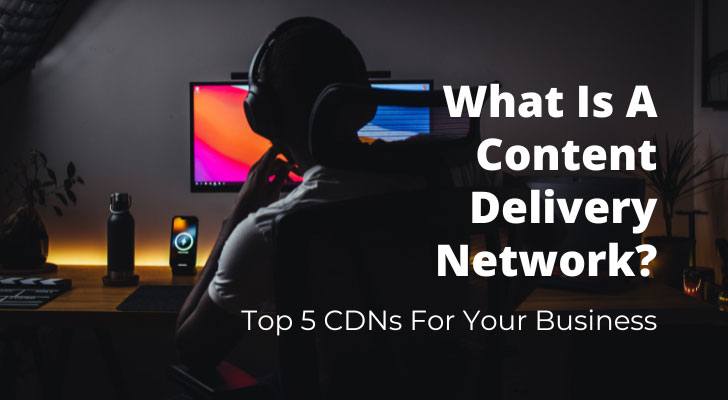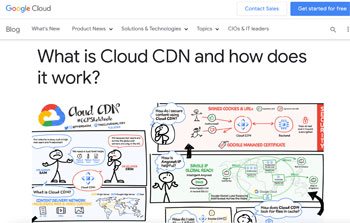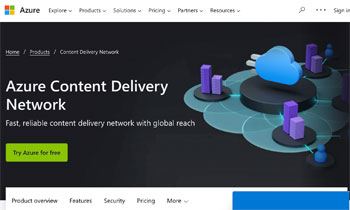A content delivery network (CDN) is a system of distributed servers that deliver webpages and other Web content to a user based on the geographic locations of the user, the origin of the webpage and the content delivery server. Content delivery networks are a critical part of ensuring optimal website performance for companies and organizations with a global audience.
By using a CDN, website content is cached at strategic locations around the world so that it can be delivered quickly and efficiently to users no matter where they are located. In this article, we will take a look at the top five CDNs currently available.

What Is a Content Delivery Network (CDN)?
A Content Delivery Network is a network of servers that delivers content to users based on their geographic location. The content is delivered from the closest server to the user, which reduces latency and improves performance. CDNs are often used to deliver high-bandwidth content, such as video or audio streaming.
What Are the Benefits of Using a CDN for a Business?
Businesses that have a large audience or receive a lot of traffic can benefit the most from using a CDN. The main benefits of using a CDN are;
- Speed Up Loading Times: A CDN can help to reduce the load on your server by caching your content at locations around the world. This means that when a user requests a page from your website, they will be able to receive it from the nearest CDN location, which can improve loading times.
- Reduce Bandwidth Costs: By caching content on servers around the world, a CDN offloads some of the traffic from the business’s own servers. This can free up bandwidth and improve website performance.
- Improve Website Security: By caching content on multiple servers, a CDN can protect your website from attacks by distributing the traffic across multiple servers. This makes it much harder for attackers to bring down your website by overloading a single server.
- Availability: A CDN can improve the availability of your website by providing redundancy. If one CDN location goes down, others can take its place. This ensures that your users will always be able to access your content, even if there are problems with one or more CDN locations.
How To Choose The Right CDN For Your Needs
There are a few things to consider when choosing a CDN for your needs;
- The size of your website. A small website will not need as much bandwidth as a large website. If you have a large website, you will need to choose a CDN that can handle the traffic.
- The location of your users. If most of your users are in one country, you should choose a CDN that has servers in that country. This will help to improve the speed of your website for those users.
- The type of content you are delivering. If you are delivering static content, such as images or text, you can choose any CDN. However, if you are delivering dynamic content, such as video or audio, you will need to choose a CDN that specializes in that type of content.
- The cost. Choose a CDN that fits within your budget.
How Does a CDN Work?
Here’s how a CDN works. CDNs are used to deliver all sorts of content, including text, images, videos, and applications. When a user requests a piece of content from a website, the CDN looks at the user's location and delivers the content from the server closest to them. This helps to improve the speed and reliability of content delivery.
Top 5 Content Delivery Network Services For Your Business
1. Cloudflare
Cloudflare is perhaps the best-known CDN service, founded in 2010 and based in San Francisco, CA. It is said to be used by more than 20% of the entire internet for web security services. It has a global network of data centres that helps to deliver content quickly and securely. Cloudflare also offers other security features, such as DDoS protection and SSL certificates.
Cloudflare offers a free plan and three paid plans: Pro, Business, and Enterprise. Cloudflare has a 100% uptime SLA. Cloudflare offers DDoS protection, SSL/TLS encryption, and a web application firewall.
2. Google Cloud CDN

Google Cloud CDN is built on the same infrastructure as Google's other global services, such as Google Search and Gmail. This means that it has access to Google's vast network of data centers and servers.
It delivers content using a global network of Edge PoPs (points of presence). Edge PoPs are servers that are located in strategic locations around the world, near where users are accessing the content. Caching content at Edge PoPs also reduces the load on the origin servers, which can improve the overall performance of the website or application.
The pricing is based on usage, so there are no upfront costs or minimum commitments.
3. Amazon CloudFront
Amazon CloudFront was established in 2008 and is operated by Amazon Web Services. In July 2020, the service operated from 205 “edge” server locations across six continents. It’s a secure network that uses encryption to protect data and is also a scalable network that can handle large amounts of traffic. This means that it can be used by websites and apps that receive a lot of traffic, without any problems.
Amazon CloudFront offers four pricing tiers: Free, Developer, Business, and Enterprise. Amazon CloudFront has a 99% uptime SLA.
4. Fastly
Fastly is another global CDN that offers fast, reliable service with a number of other features, such as security and scalability, that make it a good choice for businesses. It was founded in 2011, and As of December 2021, Fastly transfers 50–100 Tbps of data.
5. Azure Content Delivery Network

Azure Content Delivery Network is Microsoft's global service that delivers low-latency, high-bandwidth content to customers. Azure Content Delivery Network offers three pricing tiers: Standard, Classic, and Premium. Azure Content Delivery Network has a 99.9% uptime SLA.
Acceleration Data Transfers, also called Dynamic Site Acceleration (DSA), can accelerate non-cacheable content such as search results and shopping carts.
Content Delivery Network Can Be a Waste of Money
If you are a small business owner running your own blog website, forget it. Content delivery networks are nothing more than a network of servers that store copies of the content and deliver it to users based on their location.
CDNs are only helpful if you have users in multiple locations. But your site visitors may come from any part of the world, anyway. Your web hosting company will just take care of that for you.
It is also said that if your website is not configured correctly, the CDN could interfere with the way that search engines index the site. This could lead to lower search engine rankings and less traffic to the site. So you must know what you’re doing, otherwise, as a beginner online business owner, you will not need a CDN.
Do I Need a CDN for Affiliate Marketing?
If you're promoting a very popular product or service and start driving a large amount of traffic (tens of thousands per day) regularly, yes, perhaps you may want to consider using a CDN. Otherwise, there's no need to worry about scaling up your content delivery. Here are the main reasons;
- Affiliate marketing doesn't require high-bandwidth content (mostly text-based) so it can be delivered without a CDN.
- Your web hosting server should be fast enough. In fact, if your website is already fast, adding a CDN may not make much of a difference. And if your website is slow, adding a CDN may not be enough to fix the problem.
Focus on optimizing your website for speed instead, that’s all you have to do as a blogger/affiliate marketer. Optimizing, as in;
- Use a well-known website builder (e.g. WordPress) with the most up-to-date theme.
- Optimize images so they load faster.
- Use a caching plugin.
What Is A Content Delivery Network? Conclusion
CDNs can be used for a variety of content, including text, images, videos, and applications. Many businesses use CDNs to improve the performance of their website and reduce their dependence on single points of failure.
If you run a local business and have a lot of site visitors regularly, a CDN can improve the performance of your campaigns and help you to better meet the needs of your customers. The list of top 5 content delivery networks should help you research their unique features and pricing structure.
How I "Finally" Make Over $7,000 Monthly Income
"The most valuable thing I've ever done!"
